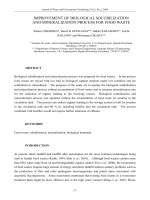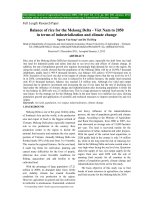mass balance of glaciers and ice caps
Bạn đang xem bản rút gọn của tài liệu. Xem và tải ngay bản đầy đủ của tài liệu tại đây (91.01 KB, 55 trang )
Module 9001
Mass Balance
Paul Ashall, 2008
The accounting of all mass in a
chemical/pharmaceutical process is referred
to as a mass (or material) balance.
Paul Ashall, 2008
Uses
• ‘day to day’ operation of process for
monitoring operating efficiency
• Making calculations for design and
development of a process i.e. quantities
required, sizing equipment, number of items
of equipment
Paul Ashall, 2008
Simple example – batch mixing
process
200 kg of a 40% w/w methanol/water solution
is mixed with 100 kg of a 70% w/w
methanol/water solution in a batch mixer
unit.
What is the final quantity and composition?
Paul Ashall, 2008
continued
Total initial mass = total final mass = 300 kg
Initial methanol mass = final methanol mass
80 + 70 = final methanol mass = 150 kg
Therefore final composition of batch is
(150/300) x 100 = 50 % by wt.
Paul Ashall, 2008
Exercise
1000 kg of 8% by wt. sodium hydroxide
(NaOH) solution is required. 20% sodium
hydroxide solution in water and pure water
are available. How much of each is
required?
Paul Ashall, 2008
Batch processes
Batch processes operate to a batch cycle and
are non-steady state. Materials are added to
a vessel in one operation and then process is
carried out and batch cycle repeated.
Integral balances are carried out on batch
processes where balances are carried out on
the initial and final states of the system.
Paul Ashall, 2008
Batch cycle
• Sequence of operations/steps repeated
according to a cycle
• Batch cycle time
• Batch size
Paul Ashall, 2008
Simple batch reaction cycle
3 steps
Add reactants etc
reaction
Empty reactor
Next cycle
Start cycle t=0
t, finish cycle
Paul Ashall, 2008
Continuous processes
These processes are continuous in nature and
operate in steady state and balances are
carried out over a fixed period of time.
Materials enter and leave process
continuously.
Paul Ashall, 2008
Law of conservation of mass
When there is no net accumulation or
depletion of mass in a system (steady state)
then:
Total mass entering system = total mass
leaving system
or total mass at start = total final mass
Paul Ashall, 2008
General mass balance equation
Input + generation – output – consumption =
accumulation
Notes: 1. generation and consumption terms refer only to generation of
products and consumption of reactants as a result of chemical reaction.
If there is no chemical reaction then these terms are zero.
2. Apply to a system
3. Apply to total mass and component mass
Paul Ashall, 2008
Definitions
•
•
•
•
System – arbritary part or whole of a system
Steady state/non-steady state
Accumulation/depletion of mass in system
Basis for calculation of mass balance (unit
of time, batch etc)
• Component or substance
Paul Ashall, 2008
Exercise
1000 kg of a 10 % by wt. sodium chloride
solution is concentrated to 50 % in a batch
evaporator. Calculate the product mass and
the mass of water evaporated from the
evaporator.
Paul Ashall, 2008
Mixing of streams
F2
F1
F4
F3
Paul Ashall, 2008
Example
Calculate E and x
evaporator feed E, composition x%
Fresh feed 1000kg, 15%
by wt sodium hydrogen carbonate
Recycle stream 300 kg, 10% satd. soln.
Paul Ashall, 2008
Flowsheets
• Streams
• Operations/equipment sequence
• Standard symbols
Paul Ashall, 2008
Flowsheets
• Process flow diagram
• PID
Paul Ashall, 2008
Typical simple flowsheet
arrangement
Recycle of unreacted material
reactor
Fresh feed
(reactants, solvents,
reagents, catalysts etc)
Separation &
purification
waste
Paul Ashall, 2008
product
Byproducts/coproducts
Exercise
A 1000 kg batch of a pharmaceutical powder
containing 5 % by wt water is dried in a
double cone drier. After drying 90 % of the
water has been removed. Calculate the final
batch composition and the weight of water
removed.
Paul Ashall, 2008
Exercise – batch distillation
1000 kg of a 20% by wt mixture of acetone in
water is separated by multistage batch
distillation. The top product (distillate)
contains 95% by wt. acetone and the still
contains 2% acetone. Calculate the amount
of distillate.
Paul Ashall, 2008
Use of molar quantities
It is often useful to calculate a mass balance
using molar quantities of materials and to
express composition as mole fractions or
mole %.
Distillation is an example, where equilibrium
data is often expressed in mole fractions.
Paul Ashall, 2008
Molar units
• A mole is the molecular weight of a substance
expressed in grams
• To get the molecular weight of a substance you need its
molecular formula and you can then add up the atomic
weights of all the atoms in the molecule
• To convert from moles of a substance to grams
multiply by the molecular weight
• To convert from grams to moles divide by the
molecular weight.
• Mole fraction is moles divided by total moles
• Mole % is mole fraction multiplied by 100
Paul Ashall, 2008
Molar units
Benzene is C6H6. The molecular weight is
(6x12) + (6x1) = 78
So 1 mole of benzene is 78 grams
1 kmol is 78 kg
Paul Ashall, 2008
Exercise – batch distillation
1000 kmol of an equimolar mixture of
benzene and toluene is distilled in a
multistage batch distillation unit. 90 % of
the benzene is in the top product (distillate).
The top product has a benzene mole fraction
of 0.95. Calculate the quantities of top and
bottom products and the composition of the
bottom product.
Paul Ashall, 2008









